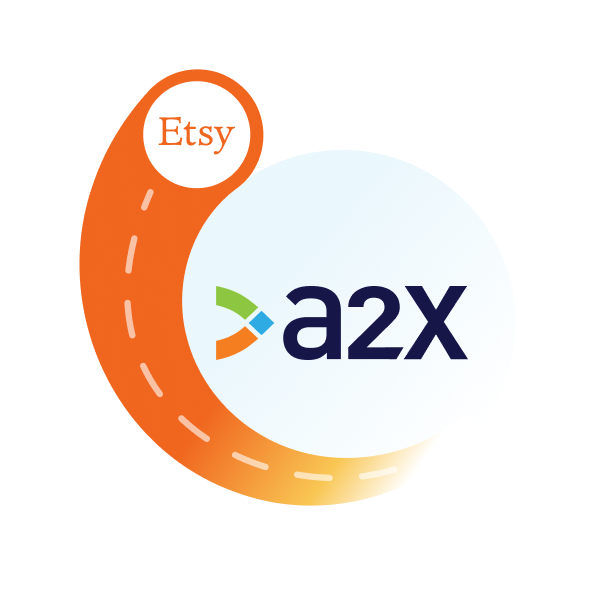![How To Set Up An Etsy Seller Account [Tutorial]](/img/content/etsy.jpg)
How To Set Up An Etsy Seller Account [Tutorial]

So you’re thinking about joining the Etsy family? Exciting!
Etsy is the platform for creatives, where imagination comes to life and buyers love personal touches. It’s all about the hand-made, human feel, but it does need to start with some techy steps first.
Setting up your Etsy seller account is very easy, and this article will show you exactly how (as well as the crucial next step).
In this article on how to set up an Etsy seller account:
Table of Contents
Integrate Etsy and your accounting software for accurate accounting
A2X auto-categorizes your Etsy sales, fees, taxes, and more into accurate summaries that make reconciliation in your general ledger a breeze.
Try A2X today
Let’s get started.
How To Set Up An Etsy Seller Account
Hopefully you’ve done a little research and planning by now to get ready for your store opening.
If not, you can find our Etsy Business Plan Template here, with all the steps to set yourself up for success before this next part.
Done all that and good to go? Let’s do it.
1. Create an Etsy seller account login
Scroll to the bottom of the Etsy homepage and click Sell on Etsy.
Scroll down and click Open your Etsy shop.
Enter your business’s email address and click Continue.
Enter your first name and create a password. Then click Register.
Confirm your account by clicking the link in the email sent from Etsy. You’ll then be taken back to your Etsy seller account.
2. Set up your Etsy shop preferences
Once you’ve confirmed your email address you’ll need to click Open your Etsy shop again or click the shop manager icon at the top right of the screen, shown below.
The first part of setting up your Etsy store preferences begins with entering your shop language, country, and currency.
NB: Once this step is saved you won’t be able to change the shop language, you’ll only be able to add languages.
Click Save and continue to move onto the next step.
3. Name your shop
It’s perhaps the trickiest part of all? Naming your shop!
You won’t be able to use a name that is already registered, so you may want a few backup plans at the ready.
Your Etsy shop name must consist of:
- 4-20 characters.
- No spaces and no special characters.
- No profanity.
- Cannot use trademarked names. Check if your name is trademarked here.
For more help with your shop name, Etsy also has a dedicated guide here.
Once you’ve chosen your name click Save and continue.
4. Create listings
You need to create at least one listing during the setup of your Etsy shop.
Click Add a listing to begin. There is a $0.20c listing fee for each one you create and for each renewed listing.
Add your product photos. You can adjust the thumbnail of the primary photo and reorder the photos by dragging and dropping.
You can also add a video of your product.
Enter the listing details of the product, including:
- Title: Name your product, using keywords to optimize search results.
- About this listing: Describe your product in detail. It will also need to be categorized as handmade, vintage or craft supply.
- Category: Where will your listing appear on Etsy?
- Renewal options: Choose how you’d like your listings to renew after four months, automatically or manually.
- Type: Your product will be either physical or digital. Selecting the digital version will swap your shipping options to be uploading options.
Enter a short product description using smart keywords. You can find tips and advice on this here.
If your product has features that are physically produced by an individual or company separate from your Etsy business then you’ll need to enter their details into the production partner section.
- Section: These are similar to categories and help shoppers find you.
- Tags and materials: These are shapes, colors, styles, functions and fabrics etc.
Enter the price of your product and the quantity you currently have in inventory. For help on pricing your products, try this helpful Etsy article.
You can enter a SKU here if you use them. A SKU is made up of letters and numbers which can help describe the product type and where it is located in your storage system. See more about SKUs on Etsy here.
Clicking Add variations allows you to add different sizes or materials of your product which your customers can choose from. You can also adjust the price and inventory quantity of each.
If your product can be personalized, such as by engraving or printing, enter the instructions that’ll be sent to your customers under the personalization section.
Etsy will calculate the shipping costs based on the size and weight of your product, or you can enter your calculated shipping costs yourself.
You also have the option to offer free shipping which is an effective selling tool for buyers today. Check out more about this here.
Save delivery profiles so you can use the shipping calculation for future listings.
For digital products, instead of entering shipping information, you’ll need to upload the digital file.
Once you’ve entered all of the listing information, you can preview your listing. If you’re happy with how it’s looking, click Save and continue.
You can add more listings or move onto the next stage of setting up your Etsy seller account.
5. Add your details and payment information
Select your business type. Find help with this here.
Fill in the following form with your personal information.
Select the country where your bank is located. A box will appear to enter your bank account details, and Etsy will deposit payments into this account.
Click Save and continue.
6. Set up billing
The final stage is to add a credit card. Etsy will charge the fees owing for your listings to this card on the first day of each month.
Once you have added your details, click Open your shop.
7. Verify your bank account
Etsy will deposit a small payment into your bank account in order to verify the details are correct. Start this process by logging into your Etsy seller account and following these instructions.
Navigate to Shop Manager > Dashboard > Shop Advisor > Verify Account.
8. Accessing your Etsy shop manager
Once you’ve completed the setup of your account, use your Etsy seller account login to access the shop manager by clicking the icon in the top right-hand corner.
The shop manager is where you can:
- Create, edit, renew, and delete listings.
- Message your customers.
- Manage your orders and get postage labels.
- View statistics.
- Manage and optimize the marketing of your product.
- Change your settings.
- Find out what Etsy offers for growing your business, things like:
While you’re at it, set up A2X for Etsy for easy accounting
Accounting can be time-consuming, which is not ideal for a seller that makes their own products.
Integrate A2X for Etsy with your store and accounting software to shave hours off your reconciliation process knowing your finances will still be accurate, reliable and automatic.
A2X captures all your settlement data and calculates it for you, posting each income and expense line per bank deposit into neat journal summaries straight into your accounting software. No more guesswork about what you have spent and collected, A2X even keeps inventory quantities for you as orders are made.
Going a step further, A2X also organizes your books via the accrual method, giving you the clearest picture of your business financials both now and in the future.
Gift yourself back the time to keep making and innovating! Try A2X for Etsy & QuickBooks Online or Xero today!
Setting up an Etsy account FAQ
How do I open an Etsy seller account?
You can open an Etsy shop by visiting sell on Etsy, clicking Open your Etsy shop, and filling out each of the sections.
You can also follow along with our instructions for how to set up an Etsy seller account in this blog.
What do I need to set up an Etsy seller account?
You’ll need to have at least one item that is ready to sell which is either handmade, vintage, or a craft supply. You’ll also need a credit card and your bank account details.
Although it is not required, a business plan can help you be prepared when setting up your Etsy seller account. Find out how to create an Etsy one here.
How much does it cost to set up an Etsy shop?
It is free to join Etsy and to set up an Etsy shop. However, each listing you create costs $0.20c and you’re required to create at least one listing during the Etsy account setup.
Once your Etsy seller account is complete, the listings you’ve created will become active and the listing fees will be charged against your credit card at the beginning of the next calendar month.
Do I need a license to sell on Etsy?
You aren’t required to hold a business license to sell on Etsy. If you do hold a business license you will need to disclose this information when setting up your Etsy seller account for tax purposes.
Also on the blog
Integrate Etsy and your accounting software for accurate accounting
A2X auto-categorizes your Etsy sales, fees, taxes, and more into accurate summaries that make reconciliation in your general ledger a breeze.
Try A2X today


